Dwarf tulip: varieties, cultivation, application
Tulips - one of the first spring flowers. That is why they are so popular. Each grower prefers certain varieties. Many people like large, with large flowers, and this is understandable. But dwarf tulips have their own benefits.
Content:
- Features of the structure and varieties
- Planting dwarf tulips
- Dwarf tulip care
- Diseases and pests
- The use of tulips
Features of the structure and varieties
Dwarf (also called pretty) tulip refers to perennial bulbous plants. It belongs to the 15th class of tulips. Its height does not exceed 10 cm. The shape of the bulb is slightly different from other primroses. It is oval, its surface is covered with brown, yellow or orange scales. The diameter of the bulb is small, from 1 to 2 cm. The peculiarity of the structure of the bulb is a fringe of hairs at the top.
Leaves are linear, not numerous, there can be from 3 to 5. They are located near the ground itself, they can even lie on it. First, up to three small leaves of green color with a silvery sheen appear. If the tulip grows in a sunny place, a red border appears on the leaves. The maximum leaf width is 1 cm. In length, they can grow up to 12 cm.
The flowers are simple, broadly bell-shaped, slightly similar in shape to crocus, with pointed petals.
The inner part of the petals is colored with different colors, bright and light, from white to purple. There are red, pink, purple flowers. There are terry varieties. The center of the flower can be in contrast to the main color, yellow, blue with a white border. Some varieties have an asymmetrical flower. The flower stamens of a single bulb often vary in color, from light brown to deep purple. This dwarf tulip differs from other flowers.
The outer side of the petals can differ significantly from the inner side, be gray-haired, white, dark purple or brown. The petals open in the morning, close in the evening. Therefore, the flower in the morning and afternoon is significantly different in color. The outer color of the petals is also different for the petals that turn out to be outside after the flower is rolled up and those that go inside.
The flowering period is two weeks or a month in May or early June, depending on the climatic zone and weather conditions. They usually bloom after snowdrops and crocuses.
Review of the best varieties:
- Bakery Lilac Wonder.
- Flaxleaf Little Princesses.
- Alba Coerulea Oculata with a navy blue center and double petal rims.
- Odalisque with cherry petals and yellow center.
- Lilliput with narrow red petals, black border and blue center.
- Dream.
- Haven.
- Tet-a-tete with double red flowers.
- Violacea with purple petals and a yellow-black center.
- Persian Pearl is a narrow-leaved variety with lilac petals and a lilac interior.
- Yellow Baby.
- Blue Baby is a super dwarf with blue flowers.
Dwarf tulips reproduce seeds or kids. When propagated by seeds, varietal traits are not transmitted. But for reproduction of the base variety, which served as the basis for breeding new varieties, this method is suitable.Breeders grow new varieties from seeds, and for ordinary flower growers, reproduction by children is better.
Planting dwarf tulips
Dwarf tulips, like all bulbs, are planted in late September or early October. Choose a sunny place. You can choose the southern or eastern slope, on which there is no close occurrence of groundwater. It is advisable to arrange a drainage that will protect the bulbs from excess moisture.
The soil should be loose and fertile with a pH of 7.0. Dwarf tulips grow best in sandy and loamy soils. To improve the composition of the soil, add sand or clay, peat, humus.
Landing rules:
- Each onion is placed in a small well. Its width is up to 6 cm, the distance between plants is 10 cm. The depth of the hole is equal to three sizes of the bulb.
- Before planting, they are disinfected for half an hour with a pink solution of potassium permanganate. You cannot stick the onion into the ground, pressing it.
- Dwarf tulips are planted in groups of about 10 pieces. In the future, they can grow to small lawns.
For the time remaining before frost, the bulb takes root. In late autumn, the site is mulched with a thick (at least 6 cm) layer of peat, compost or leaves.
Dwarf tulip care
Dwarf tulips are very hardy. They tolerate drought, wind, temperature fluctuations well. After all, they are accustomed to such growing conditions in the mountains.
Care Tips:
- Dwarf tulips begin to grow in April. When the leaves appear above the ground, the plantings of dwarf tulips are carefully examined. Shelter is removed from the areas where there was mulch. They look for plants affected by diseases. If there are any, dig them up. Such inspections are carried out periodically throughout the growing season.
- If the weather is dry, there is no rain for a long time, tulips are watered. This is especially important during the period of flower formation.
- In the same period, flowers are fed with complex mineral fertilizer... During flowering, nitrogen fertilizers are not needed, but phosphorus and potassium fertilizers are added. Watered with clean water before and after fertilization.
- The soil near the flowers is regularly loosened. This contributes to the saturation of the tulip's root system with oxygen.
- After all the flowers have faded, the peduncles are removed at a height of 5 cm. The exception is the case when you need to collect the seeds. Then they wait for the formation and maturation of the bolls. The leaves are cut when they turn yellow.
- It is not necessary to dig up the bulbs after flowering. In one place, they can grow and bloom for ten years, growing and forming beautiful groups. But usually I transplant them after 4 years. During this time, plants grow and require a lot of space.
- If you need to transfer some of the flowers to another place, the bulbs are dug out. Near them, by the middle of summer, small formations are formed, called babies. After the leaves turn yellow, they are separated from the mother plant and planted. They begin to bloom the next year.
The harvested bulbs are stored in a cool dry place, for example, in a cellar, until planting. They are pre-dried and placed in boxes so that they have access to air.
Not all varieties of dwarf tulips tolerate winter frosts well. Imported hybrids need to be covered for the winter. Indeed, at temperatures below -17 ° C, their bulbs die without shelter. Therefore, when buying a dwarf tulip of a new variety, you need to find out the wintering conditions.
Diseases and pests
Dwarf tulips can be affected by fungal diseases. These include rot, gray and sclerocial, trichoderma, rhizoctonia, penicillosis. If the buds are covered with mold, and brown spots form on the leaves, these are signs of gray rot. On the defeat of sclerocial rot, the bulbs are covered with white spots. Soon they turn black and then the bulbs rot.
Improper growing conditions contribute to diseases: lack of drainage, too abundant watering.
Treatment - treatment fungicides, drainage installation, soil replacement. Dwarf tulips are affected by viral diseases. This is the variegation of the petals, the August disease (necrotic spot). Affected plants are not treated. They are dug up together with a clod of earth and burned.
Pests of dwarf tulips:
- Wireworms and bear infect the bulbs. To combat them, they regularly weed and loosen the soil, remove weeds. Traps are laid in the soil, which after a while are checked and removed. In case of severe damage by these pests, chemical insecticides are used.
- In winter, the bulbs can be nibbled by mice. To protect against them, dwarf tulip bulbs are planted in special nets. In winter, you need to trample the snow in the area where the bulbs grow.
- Aphid sucks the juice from the plant and carries viral diseases. To combat it and other insects, you can use an insecticide or plant a trichogramma on the site. It is a biological pest control method.
The use of tulips
The homeland of dwarf tulips is the alpine meadows of Southwest Asia. This determines the place of their cultivation in gardens. Dwarf tulips are planted on alpine slides, in potted gardens (they are unpretentious to care for, do not require special care):
- In flower beds, they are placed in front of tall flowers.
- Dwarf tulips look spectacular on terraces and borders.
- Good neighbors for a dwarf tulip can be saxifrage, stonecrops, cereals.
- You can plant them in containers, where they will bloom. A layer of drainage is laid at the bottom, soil for bulbous plants is poured on top.
Plants are planted in the same way as in a flower bed. Install containers on balconies, verandas. After flowering, the containers can be removed or other plants can be planted nearby, which bloom later. These can be petunias, carnations, gazanias, succulents.
Instead of containers, you can take flowerpots. By planting different varieties, you can achieve continuous flowering of dwarf tulips throughout the month. Dwarf tulips obtained as a result of forcing look very beautiful.
More information can be found in the video:



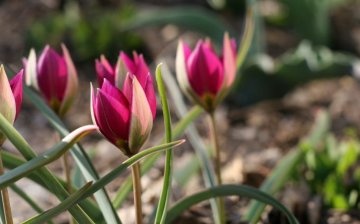

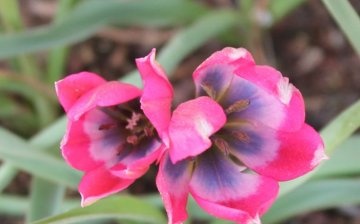
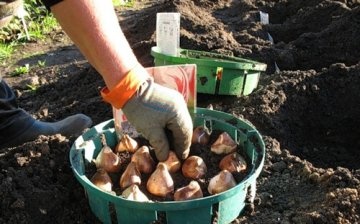

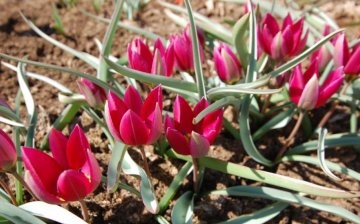








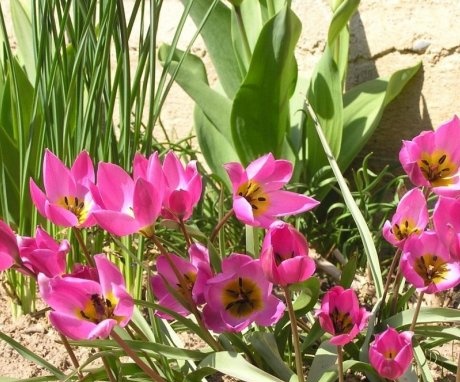
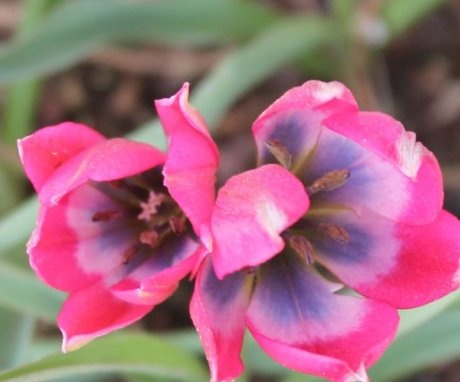
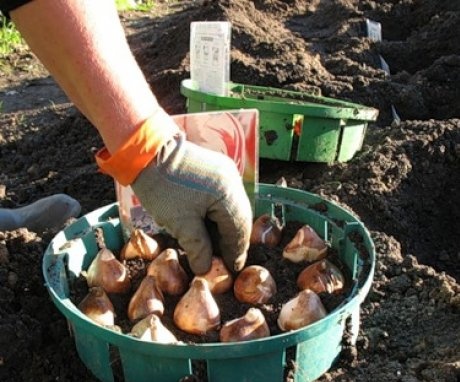
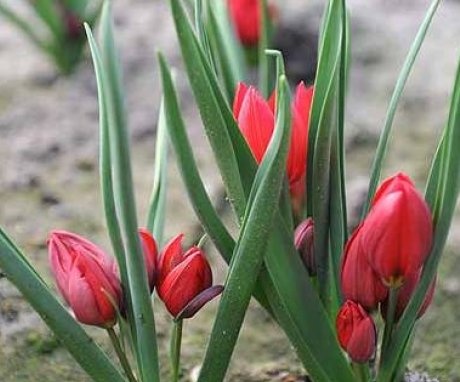
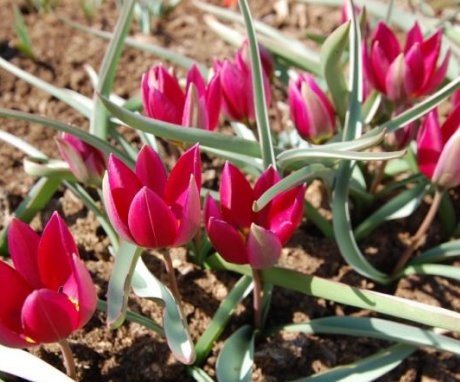
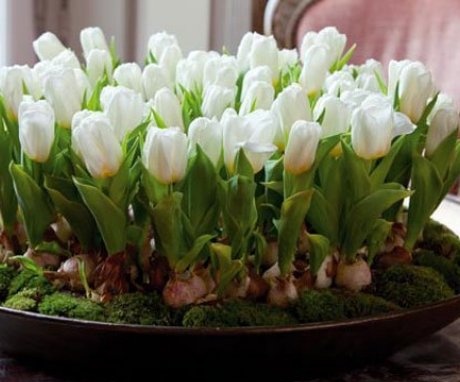
Dwarf tulips are very beautiful, but, due to their small size, they are not cut off and they grow only in flower beds. Very unusual color of the petals, outside and inside. If the stem of the flower was longer, for the eighth of March, there would be no better gift.
I understand that such tulips cannot be grown in indoor conditions, but only in the garden on your site. I really like tulips, but I did not know that there are also dwarf varieties.